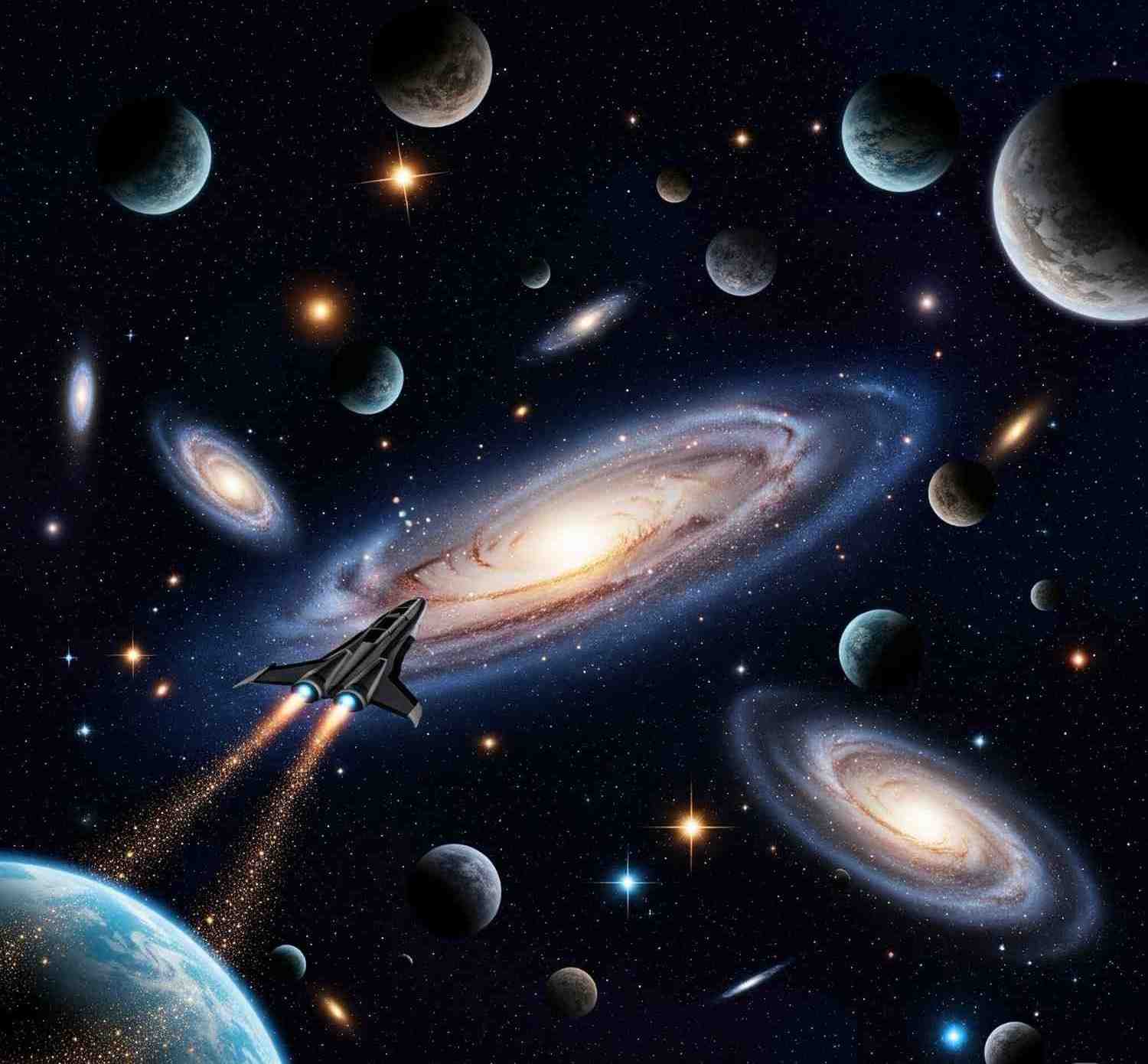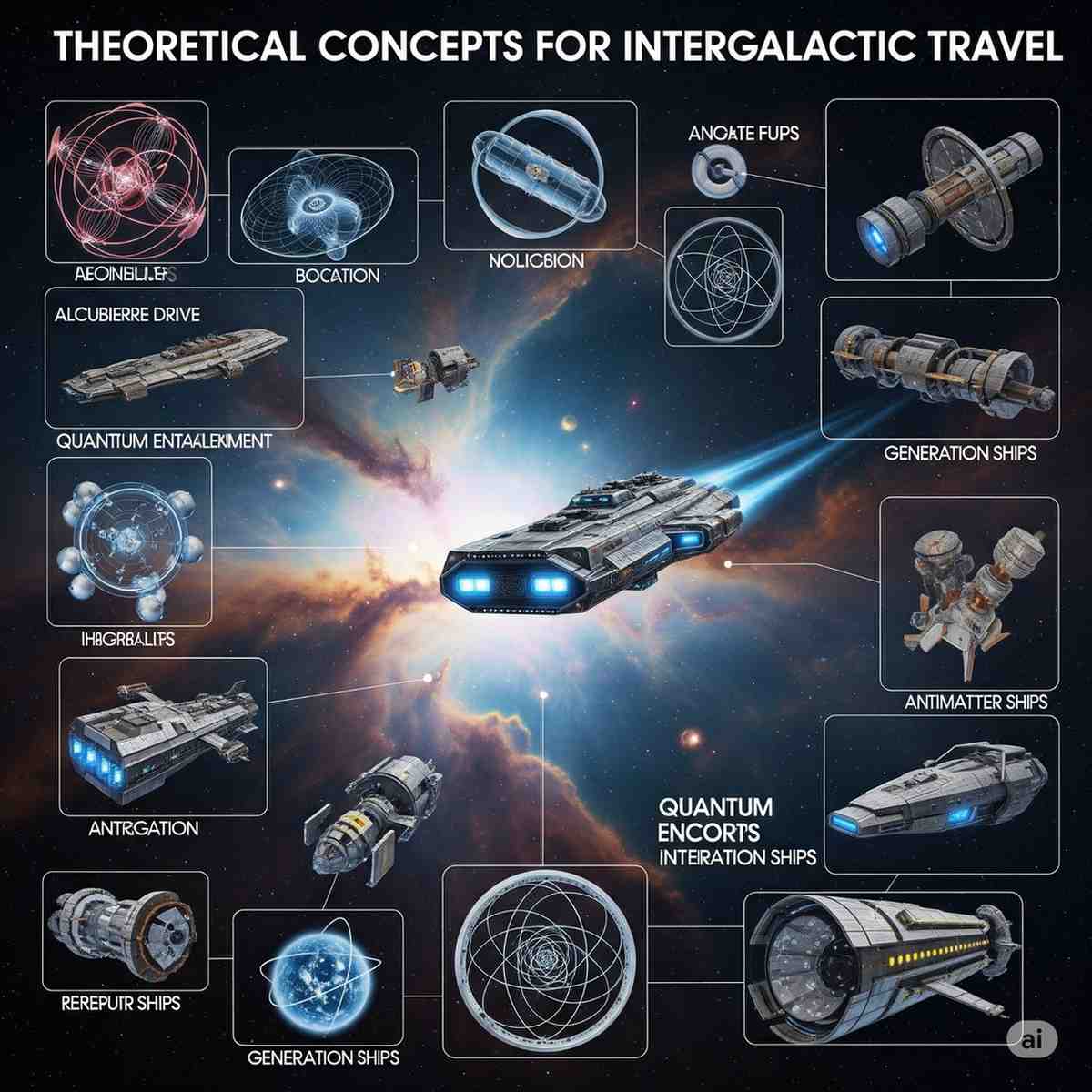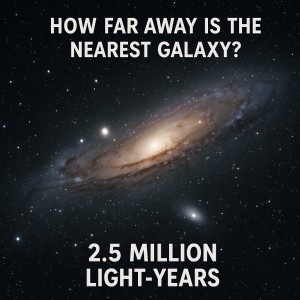exploring galaxies for way

Exploring Galaxies for Way: A Journey Through the Cosmic Web
Introduction
The universe is a vast, interconnected network of galaxies, each one containing billions of stars, planets, and mysteries waiting to be uncovered.As humanity stretches its technological limits, our gaze deepens into the distant reaches of space, seeking paths that lead not only to new worlds, but to greater knowledge.
What Are Galaxies? | Exploring Galaxies for Way
Galaxies are immense systems made up of stars, stellar remnants, gas, dust, and dark matter, all bound together by gravity. They come in various shapes: spiral, elliptical, irregular—and each type tells a story of cosmic evolution. The Milky Way, our home galaxy, is just one among over 2 trillion others.
Why Explore Galaxies?
Exploring galaxies isn’t just about curiosity—it’s about finding clues to life’s origins, the behavior of dark energy, and the destiny of the universe. Every galaxy is a chapter in a much bigger cosmic story. Exploring Galaxies for Way
- To trace the origin of stars and planets
- To search for extraterrestrial life
- To understand cosmic phenomena like black holes and quasars
- To find “ways” — navigational paths, energy resources, or even habitable zones
Technologies Leading the Way

Our tools for exploration are as fascinating as the galaxies themselves:
- Space Telescopes – Like Hubble, James Webb, and upcoming ones like the Nancy Grace Roman Telescope.
- Radio Astronomy – Detecting invisible signals from distant galaxies.
- AI & Big Data – Processing massive datasets from deep-sky surveys.
- Spectroscopy – Analyzing light to learn about the composition and movement of galaxies.
Mapping the Cosmic Web
S Instead, they are arranged in vast filaments and clusters, forming a “cosmic web.” Exploring this structure helps us understand the large-scale layout of the universe and perhaps uncover hidden “ways” or pathways between galaxy clusters.
Are We Alone?
By exploring distant galaxies, we’re also hunting for biosignatures—signs of life. Exoplanets in distant systems may harbor life-friendly conditions. The search for habitable zones in other galaxies could one day point the way to intergalactic travel.
The Future of Galactic Exploration
While human travel to other galaxies is still a dream, advanced robotics, quantum communication, and faster-than-light theories (like warp drives) continue to fuel our vision. Missions like Breakthrough Starshot are already experimenting with interstellar concepts
“Is There a Way to Travel Between Galaxies?”

Introduction: The Ultimate Frontier
For centuries, humanity has gazed into the night sky, captivated by the vastness of the cosmos. Among the grandest questions we ask is: Can we travel between galaxies? It’s a concept rooted in science fiction but now increasingly discussed in scientific circles. But in a universe as mysterious as ours, even the impossible might someday become achievable.Exploring Galaxies for Way
Understanding Galactic Distances
To appreciate the difficulty, it’s important to understand scale. Our Milky Way Galaxy spans about 100,000 light-years in diameter and contains over 100 billion stars. Traveling to the edge of our galaxy alone is beyond our current capabilities, let alone jumping to another.Exploring Galaxies for Way
At the speed of Voyager 1 (about 17 km/s), it would take over 40 trillion years to get there — vastly longer than the age of the universe itself.
Theoretical Concepts for Intergalactic Travel

Despite the distance, science offers hypothetical frameworks for how intergalactic travel might one day be achieved:
1. Warp Drives
Inspired by Einstein’s general relativity, a warp drive would compress space in front of a ship and expand it behind, allowing faster-than-light travel without violating physics. The Alcubierre Drive, a popular theory, suggests creating a “warp bubble” for this. However, it currently requires exotic matter with negative energy—something we’ve never observed.Exploring Galaxies for Way
2. Wormholes
Also known as Einstein-Rosen bridges, wormholes are theoretical tunnels through space-time connecting distant parts of the universe. If stable and traversable, they could allow instant passage between galaxies.
3. Generation Ships
If speed can’t be increased, we may resort to slow but steady travel. A generation ship would carry hundreds or thousands of people who live, reproduce, and die during a voyage spanning thousands or even millions of years. This method leans more on social engineering and sustainability than physics.
4. Cryogenic Sleep or Time Dilation
Stasis chambers or cryo-sleep could allow humans to endure centuries-long travel by “sleeping” through the journey. However, the massive energy needed and radiation risks make this approach challenging. Exploring Galaxies for Way
Technological and Energy Challenges
The biggest roadblocks to intergalactic travel are:
- Energy Requirements: Accelerating even a small spacecraft to relativistic speeds requires astronomical amounts of energy.
- Radiation and Micrometeoroids: At high speeds, tiny particles could cause catastrophic damage.
- Propulsion Limitations: Chemical rockets are far too slow; we’d need breakthroughs in nuclear propulsion, ion drives, or antimatter engines.
What About Alien Civilizations?
The Fermi Paradox—”Where is everybody? One possibility is that intergalactic travel is simply too hard, even for advanced civilizations. Or maybe they know how—but choose not to interfere.
Hope on the Horizon
While intergalactic travel is still far from reality, humanity is making strides:
- Projects like Breakthrough Starshot aim to send tiny probes to nearby stars using laser propulsion.
- Advances in quantum physics, fusion energy, and AI could pave the way for smarter, faster exploration.
-
Can We Travel to the Andromeda Galaxy? A Deep Dive Into Intergalactic Possibilities
- But the question that ignites curiosity in both scientists and science fiction fans is: Can we ever travel to Andromeda?
- Let’s explore this idea through the lens of current technology, theoretical physics, and the sheer scale of the cosmos.
-
Understanding the Immensity of Distance
- To grasp the challenge, we must first comprehend just how far Andromeda is.That means Andromeda is:
- 2,537,000 x 9.46 trillion km = 24 quintillion kilometers away.
- Even the fastest spacecraft ever built, NASA’s Parker Solar Probe, travels at about 700,000 km/h. At that speed, it would take:
- Over 4 billion years to reach Andromeda.
- That’s nearly the age of Earth itself.
-
What Are the Possible Methods of Intergalactic Travel?
-
1. Conventional Propulsion
- Our current rockets—chemical or ion-based—are not remotely capable of such a journey. They’re great for nearby planets and maybe outer solar system missions, but not for multi-million light-year voyages.Exploring Galaxies for Way
-
2. Nuclear Propulsion (Project Orion & Beyond)
- Nuclear propulsion concepts suggest using nuclear explosions to push a spacecraft to much higher speeds than chemical rockets. Though powerful, even the most optimistic nuclear designs wouldn’t bring Andromeda within reach for millennia.
-
3. Antimatter Engines
- Antimatter reactions could theoretically release enormous energy—nearly 100% mass-to-energy efficiency—far beyond what nuclear or chemical engines can achieve. However, creating and storing antimatter is currently impractical and extremely costly.
-
4. Alcubierre Warp Drive (Faster-than-Light Travel)
- Proposed by physicist Miguel Alcubierre, this hypothetical concept would contract space in front of a ship and expand it behind, moving space itself rather than the craft. It obeys Einstein’s equations but would require exotic matter with negative energy—a substance we haven’t discovered or created.
-
5. Wormholes
- Popular in science fiction, wormholes could potentially connect distant points in spacetime instantly. Theoretically possible under General Relativity, but again, no experimental evidence exists and the engineering hurdles are astronomical. Exploring Galaxies for Way
-
The Problem of Time
- Even if we could travel close to the speed of light using some future propulsion method, time dilation (as predicted by Einstein’s theory of relativity) would occur. For travelers on the ship, the journey might seem shorter, but millions of years would pass on Earth. You’d arrive in Andromeda—but your world would have aged or changed beyond recognition. Exploring Galaxies for Way
-
Cosmic Hazards Along the Way
- Intergalactic space isn’t just empty vacuum.
-
What About Sending Probes? | Exploring Galaxies for Way
- Projects like Breakthrough Starshot aim to send gram-scale probes to nearby stars using light sails propelled by high-powered lasers. Scaling this up to intergalactic distances is a far future goal, but may serve as the first baby step.Exploring Galaxies for Way
-
The Ultimate Roadblock: Human Lifespan
- Even with advances in propulsion, humans have limited lifespans. Without breakthroughs in cryogenics, genetic engineering, or generational starships, a manned mission to Andromeda is nearly impossible with today’s understanding of biology and physics.
-
Is Interstellar Travel Possible? Unlocking the Universe’s Greatest Journey | Exploring Galaxies for Way
- Interstellar travel—the idea of voyaging beyond our solar system to explore distant stars and exoplanets—has long captivated humanity’s imagination. From the visionary pages of science fiction to the cutting-edge research of modern astrophysics, this grand concept stands as one of the most ambitious frontiers of exploration. But the question remains: Is interstellar travel truly possible, or will it forever be a cosmic dream?
-
The Immensity of Interstellar Space | Exploring Galaxies for Way
- Before diving into possibilities, it’s crucial to understand the sheer scale of the challenge. That translates to approximately 41 trillion kilometers (25 trillion miles)—a distance so vast that our fastest spacecraft would take tens of thousands of years to reach it.
- Clearly, if interstellar travel is to become a reality, revolutionary breakthroughs in propulsion and physics are necessary.Exploring Galaxies for Way
-
Barriers to Interstellar Travel | Exploring Galaxies for Way
-
1. Energy Requirements
- Accelerating a spacecraft to 10% the speed of light would demand energy comparable to the total global output over several years.Exploring Galaxies for Way
-
2. Time Dilation and Aging
- Einstein’s theory of relativity introduces time dilation—meaning that time passes slower for travelers moving near light speed. While this could be advantageous (astronauts might age slower), the psychological and social implications of leaving Earth behind for what might be a one-way trip are significant.Exploring Galaxies for Way.
-
3. Cosmic Hazards
- A spacecraft traveling at extreme speeds would need advanced shielding to survive these dangers, which adds further mass and complexity.
-
Theoretical Solutions: From Science Fiction to Emerging Science | Exploring Galaxies for Way
- While today’s rockets are limited by chemical propulsion, numerous theoretical technologies are being researched:
-
1. Nuclear Propulsion
- Concepts like Project Orion and Project Daedalus proposed spacecraft powered by controlled nuclear explosions or fusion reactions. These could potentially reach up to 10% of light speed.
-
2. Light Sails
- Pioneered by Breakthrough Starshot, this idea involves tiny spacecraft propelled by high-powered lasers from Earth, pushing ultra-light sails to immense speeds. While still in the experimental phase, it’s one of the few concepts grounded in known physics.Exploring Galaxies for Way
-
3. Antimatter Engines
- Antimatter-matter collisions release tremendous energy—perfect for propulsion.
-
4. Warp Drives and Wormholes
- These remain speculative, based on solutions to Einstein’s field equations. The Alcubierre Drive, a theoretical concept, suggests space could be “warped” to move faster than light without violating relativity. But it currently requires exotic matter—a substance not yet discovered.
-
Could Artificial Intelligence Lead the Way? | Exploring Galaxies for Way
- Rather than sending humans, AI-powered probes or digital consciousness uploads could serve as vanguards of interstellar exploration. These missions would bypass the limitations of biology, though ethical and philosophical questions arise about sentience and autonomy.
-
The Timeframe: When Might It Happen?
- Interstellar travel won’t happen tomorrow—or likely even in this century. But the seeds are being planted today. With continued advancements in quantum physics, space propulsion, and material science, it’s possible that future generations could build the first starships.
- What’s more, growing interest from private space companies, national space agencies, and international collaborations might accelerate progress beyond what we expect. Exploring Galaxies for Way
-
A Philosophical Perspective|Exploring Galaxies for Way
- Is interstellar travel just about reaching another star? Or is it about expanding the boundaries of what it means to be human? The journey to the stars is also a journey inward—of discovery, ambition, and the eternal desire to transcend limits.
- The dream of reaching the stars has lived in humanity’s imagination for centuries. From ancient stargazers charting constellations to modern space agencies launching robotic probes, our species has always looked up and asked the most cosmic of questions: Can we ever go there? More specifically—will humans ever reach another star?
- 🚀 The Distance Problem: Just How Far Are the Stars?
- The closest star system to Earth is Alpha Centauri, located a staggering 4.37 light-years away. To put that in perspective, if Earth and the Moon were one centimeter apart, Alpha Centauri would still be more than 300 kilometers away. Current technology simply doesn’t have the capability to traverse such vast distances in a human lifetime.
- The fastest spacecraft ever built—NASA’s Parker Solar Probe—travels at about 700,000 kilometers per hour, yet it would still take over 6,000 years to reach the nearest star.
- ⚙️ Theoretical Technologies: Beyond Rockets
- To close this astronomical gap, scientists are exploring radical propulsion concepts that break away from traditional chemical rockets:
- 🌌 1. Nuclear Fusion Propulsion
- Using the power of controlled nuclear fusion—similar to what powers the sun—could dramatically increase speed. Projects like Project Daedalus and Project Longshot explored this decades ago. Though still theoretical, fusion propulsion could cut interstellar travel times down to centuries or even decades.Exploring Galaxies for Way
- ☄️ 2. Light Sail Propulsion
- Imagine a spacecraft with a sail pushed by powerful lasers from Earth. This is the concept behind Breakthrough Starshot, a privately funded initiative aiming to send gram-scale probes to Alpha Centauri within a few decades. While not for humans (yet), it’s a critical first step in interstellar exploration.Exploring Galaxies for Way
- 🌀 3. Warp Drives and Wormholes
- Popularized by science fiction, these concepts involve bending space-time itself. The Alcubierre Drive, based on real math, suggests a way to create a bubble of space-time to move faster than light—without violating physics. However, it requires exotic matter we haven’t yet discovered.
- 👨🚀 Human Challenges: Biology Meets Deep Space
- Even if we had the engines, human space travel to other stars introduces massive biological challenges:
- Time: Multi-decade journeys would span generations. Would we send families? Or rely on cryogenic sleep?
- Psychology: Isolation from Earth for a lifetime could have serious mental health effects.
- To make this possible, we’d need advances in biomedicine, life-support systems, and possibly even genetic adaptation to survive the deep void of space.
- 🪐 Why It Matters: The Case for Interstellar Ambition
- Why should we even try to reach other stars? The answers are deeply philosophical and existential:
- Survival: Earth won’t last forever. If we want to ensure the survival of our species, interstellar migration may one day be necessary.
- Discovery: Other planets may harbor life—or the building blocks of it. Understanding them may help us understand ourselves.
- Wonder: The pursuit of distant stars unites humanity’s scientific progress with its imagination. It’s a quest for meaning as much as for exploration.
- 🔭 A New Cosmic Era
- In truth, humans will not reach another star anytime soon—not in our generation, perhaps not even in this century. But the seeds are being planted today. Robotic missions, exoplanet discoveries, and next-gen propulsion research are building the roadmap for a future where the stars are not just lights in the sky, but destinations.
-
Is There Any Truth to Interstellar? | Exploring Galaxies for Way
-
Exploring the Science Behind the Sci-Fi Epic
- Christopher Nolan’s Interstellar is widely praised not just for its stunning visuals and emotional depth, but for its ambition to weave real astrophysics into a blockbuster narrativeLet’s break down the facts and fiction behind this cinematic journey through space, time, and dimensions.Exploring Galaxies for Way
-
1. Gargantua: The Realistic Black Hole
- The film enlisted physicist Kip Thorne, a Nobel laureate, to ensure scientific realism—particularly in depicting gravitational lensing. This is why the black hole in the movie appears as a glowing ring of light around a shadowy sphere.🪐 Truth Level: Very High
The depiction was so precise that it contributed to scientific papers on gravitational optics. -
2. Time Dilation on Miller’s Planet |Exploring Galaxies for Way
- One of the most mind-bending moments occurs on Miller’s Planet, orbiting dangerously close to Gargantua. Due to extreme gravitational time dilation, every hour on the planet equals seven years on Earth.
- While the extreme ratio in the film pushes known limits, physicists agree it’s theoretically possible—if a planet could survive that close to a black hole without being torn apart.Exploring Galaxies for Way
- ⏳ Truth Level: Theoretically Plausible
-
3. Wormholes as Cosmic Shortcuts
- The journey to another galaxy begins with a wormhole near Saturn, allowing characters to bypass unimaginable distances in space. Wormholes are a solution to Einstein’s field equations and could theoretically allow instant travel between distant parts of the universe.
- The catch? We have no experimental evidence that they exist, and if they do, they’d likely be unstable or require exotic matter to keep open.Exploring Galaxies for Way
- 🌌 Truth Level: Mathematically Valid, But Unproven
-
4. Fifth-Dimensional Beings and the Tesseract
- Toward the end, Interstellar dives into speculative science as Cooper interacts with a tesseract—a space constructed by higher-dimensional beings allowing him to send messages across time using gravity.
- This part enters the realm of quantum gravity, string theory, and extra dimensions—fields still shrouded in mathematical abstraction. While fascinating, this portion leans more on imagination than established science.
- 🧠 Truth Level: Speculative, But Conceptually Rooted in Theoretical Physics
-
5. The Blight and Earth’s Decline
- The dying Earth shown in Interstellar is suffering from crop failures and dust storms due to a global blight and changing climate. While the exact mechanism isn’t deeply explained, it resonates with real fears about climate change, soil degradation, and loss of biodiversity.
- 🌍 Truth Level: Grounded in Environmental Science
🌌 Where Is Voyager 2 Now? — Tracing Humanity’s Far-Flung Ambassador
Over 47 years later, Voyager 2 continues its incredible journey into the vast interstellar void, well beyond the boundaries of our solar system. But where exactly is it now?
🛰 A Journey Beyond the Solar System
Voyager 2 was launched 16 days before Voyager 1 but took a different path, enabling it to visit all four gas giants: Jupiter, Saturn, Uranus, and Neptune—a feat no other spacecraft has accomplished. After these flybys, it began its long cruise toward interstellar space.
In November 2018, Voyager 2 officially crossed the heliopause—the boundary where the solar wind from our Sun is stopped by the interstellar medium. This marked its entry into interstellar space, a region beyond the influence of the solar wind.
As of 2025, Voyager 2 is over 20 billion kilometers (more than 13 billion miles) from Earth. It is hurtling outward at a speed of about 15 kilometers per second (roughly 35,000 miles per hour), and every day, it travels about 1.3 million kilometers farther from Earth.
📡 Communicating Across the Stars
These signals take over 18 hours to reach us—at the speed of light. NASA’s Deep Space Network (DSN) receives and processes these whisper-like messages. The spacecraft’s power source, a radioisotope thermoelectric generator (RTG), is slowly fading, and engineers have shut down some instruments to conserve energy. Yet, it continues to deliver valuable data about the interstellar environment.Exploring Galaxies for Way
🧭 What Is Voyager 2 Doing Now?
Currently, Voyager 2 is drifting through the interstellar medium, a vast ocean of gas, dust, and plasma that exists between star systems in the Milky Way. Its instruments are still detecting:
- Cosmic rays
- Magnetic fields
- Plasma waves
- Low-frequency radio signals
By analyzing this data, scientists are learning how the heliosphere—the protective bubble around our solar system—interacts with the broader galaxy.Exploring Galaxies for Way
🎶 The Golden Record: A Message for the Cosmos
Voyager 2 carries a Golden Record, a 12-inch, gold-plated copper disc containing sounds and images from Earth, including greetings in 55 languages, music by Beethoven and Chuck Berry, and a collection of natural Earth sounds like thunder and birdsong🪐 What Lies Ahead?Long after it stops communicating—likely by 2030, when its power runs out—it will continue its silent voyage through the galaxy, a ghostly emissary of Earth traveling among the stars.
the brightest star in our night sky.
🌠 Voyager 2: A Symbol of Cosmic Exploration
Voyager 2 is more than just a spacecraft. It is a monument to human ingenuity, a testament to our desire to reach beyond the horizon.
So, where is Voyager 2 now? It’s out there—alone, ancient, and awe-inspiring—exploring the deep unknown, carrying a piece of humanity with it as it drifts endlessly between the stars.Exploring Galaxies for Way
-
Is Space Endless or Infinite? | Exploring Galaxies for Way
- From the time humanity first looked up at the night sky, a haunting question has echoed through our collective consciousness: Is space truly endless—or is there a limit to the cosmic expanse that surrounds us? This profound inquiry touches the very boundaries of science, philosophy, and imagination. To unravel this enigma, we must journey through astrophysical theory, observational cosmology, and the farthest reaches of human curiosity.
-
The Observable Universe: A Finite Window into the Infinite
- Our current technological reach limits us to what astronomers call the observable universe—a spherical region about 93 billion light-years in diameter, centered around Earth. This boundary doesn’t signify the edge of space itself; rather, it demarcates the furthest distances from which light has had time to reach us since the Big Bang. Beyond this luminous horizon lies an uncharted realm, perhaps expanding eternally into the cosmic abyss.
-
Cosmic Expansion and the Fabric of Spacetime
- . Thanks to the work of Edwin Hubble and others, we know that galaxies are racing away from each other at accelerating speeds. This phenomenon isn’t motion through space—it’s the expansion of space itself, like points on the surface of an inflating balloon.
- This brings forth a staggering implication: space may have no center, no edge, and no end. If the universe is flat or open—as some models suggest—it could stretch on infinitely, with no boundary or perimeter to contain it.
-
The Finite-Infinite Paradox | Exploring Galaxies for Way
- Despite all we know, the true topology of the universe remains elusive. Some theories posit that the cosmos is finite but unbounded—akin to the surface of a sphere in three dimensions. In such a universe, if you traveled far enough in one direction, you could eventually return to your starting point, much like circumnavigating the Earth.
- This paradox—finite in volume but infinite in journey—defies everyday logic and requires a deeper comprehension of non-Euclidean geometry, the very language of curved space.Exploring Galaxies for Way
-
Multiverses and the Concept of Meta-Infinity|Exploring Galaxies for Way
- Modern cosmological theories like inflation and string theory go even further, proposing that our universe might be just one bubble in a vast multiverse—a meta-cosmic expanse filled with an infinite In this context, the question of whether space is infinite may be only the tip of the existential iceberg.Exploring Galaxies for Way
-
Human Perception vs. Cosmic Reality
- Perhaps the greatest challenge is not scientific but psychological. Our minds are wired to think in finite terms—starts, ends, boundaries, edges. The concept of infinity is as terrifying as it is awe-inspiring, forcing us to confront a scale of existence far beyond human comprehension.
- To imagine an endless universe is to acknowledge our own infinitesimal place within it—a speck of dust adrift in an unfathomable void.
🌌 What Galaxy Do We Live In?
Have you ever looked up at the night sky and wondered where exactly we are in the grand scheme of the cosmos? Earth is not just floating in space by itself — we are part of a vast, magnificent system called a galaxy. So, what galaxy do we live
🌠 What Is a Galaxy?
Galaxies come in various shapes and sizes — spirals, ellipticals, and irregulars — and they float throughout the expanding universe, numbering in the billions.
🌌 Welcome to the Milky Way | Exploring Galaxies for Way
The Milky Way is our home galaxy, a sprawling spiral of stars and matter that measures around 100,000 light-years in diameter.When you look up into the night sky and see a hazy band of light stretching across the heavens, you’re actually seeing part of the Milky Way’s galactic plane, filled with billions of distant stars whose light blurs into a milky glow. That’s how our galaxy got its name — from the Latin via lactea, meaning “milky road.”Exploring Galaxies for Way
🌍 Where Are We in the Milky Way?
We are located in a region of the galaxy called the Orion Arm (or Orion Spur), a minor spiral arm situated between two major arms — the Perseus Arm and the Sagittarius Arm. Despite this incredible speed, it takes our solar system over 225 million years to make one full orbit around the galaxy’s core — a journey known as a galactic year.
🌟 What’s at the Center of Our Galaxy?
At the very center of the Milky Way lies something truly mysterious: a supermassive black hole known as Sagittarius A*. This gravitational monster has a mass equal to about 4 million suns and exerts an enormous influence on the orbits of nearby stars and cosmic matter. While it cannot be seen directly, its presence is detected through the motion of stars and radio waves it emits.Exploring Galaxies for Way
🪐 How the Milky Way Formed
t began as a cluster of gas and dark matter that slowly grew by merging with other protogalaxies.
🛸 Is the Milky Way Alone?
Definitely not. The Milky Way is part of a cosmic neighborhood called the Local Group, which includes over 50 galaxies, such as Andromeda, Triangulum, and numerous dwarf galaxies. In fact, the Milky Way and Andromeda Galaxy are on a collision course and will merge in about 4 billion years, forming a new, larger galaxy — sometimes dubbed Milkomeda by scientists.
🌌 Why the Milky Way Matters |Exploring Galaxies for Way
Understanding the Milky Way isn’t just about knowing where we live. It’s about discovering the story of the universe, how stars are born, how planets form, and possibly — how life emerges. Our galaxy is a dynamic system full of secrets: stellar nurseries, ancient star clusters, and perhaps even signs of intelligent life.
Astronomy allows us to look outward in space but also inward — to reflect on our place in the cosmos.
🧠 Fascinating Facts About the Milky Way
- The galaxy may contain over 100 billion planets, some of which could be Earth-like.
- The Milky Way is moving through space at around 2.1 million kilometers per hour.
-
What Planet Will Humans Go To? The Future of Human Exploration Beyond Earth
- As our curiosity continues to push the boundaries of science and space exploration, the question of “What planet will humans go to?” has become one of the most thought-provoking and essential inquiries for the future of humanity. The prospect of human colonization on another planet is no longer just a far-off dream; it is slowly becoming a tangible goal driven by advancements in technology, space research, and an urgent need to ensure the survival of our species. But which planet will humanity set its sights on? Let’s explore the possibilities.Exploring Galaxies for Way
-
1. Mars: The Red Frontier
- Mars has long captured the imagination of scientists, engineers, and explorers. Often Its day is close to ours, and it has a mix of the necessary ingredients for human survival, such as a stable climate and the presence of water ice at its poles.Exploring Galaxies for Way
- However, Mars presents its challenges. The planet’s atmosphere is over 95% carbon dioxide, making it inhospitable for humans without life support systems. Additionally, its gravity is just 38% that of Earth’s, which could lead to long-term health complications for astronauts. To tackle these issues, space agencies like NASA and private companies such as SpaceX are developing technologies that could make life on Mars feasible. This includes building sustainable habitats, using the planet’s resources (a concept called in-situ resource utilization), and creating methods for water extraction and oxygen generation.
- Despite these hurdles, the allure of Mars remains undeniable. It is the most accessible planet within our reach, with missions like NASA’s Artemis Program laying the groundwork for human exploration.Exploring Galaxies for Way
-
2. Venus: The Extreme Challenge
- Though Venus may seem like an unlikely destination for human colonization, the “cloud cities” concept has gained some traction in recent years. However, its upper atmosphere, located about 50 km above the surface, is a more temperate zone.
- In the clouds of Venus, conditions are relatively mild compared to the planet’s surface. Some scientists are exploring the possibility of floating colonies or aerial habitats that could harness the planet’s thick atmosphere for buoyancy. In the future, these floating cities could use advanced materials and solar power to sustain human life.
- Though still in the conceptual phase, Venus remains a planet of intrigue, with missions like NASA’s VERITAS and DAVINCI+ aiming to uncover more about its atmosphere and geology, which could one day help make human exploration possible.Exploring Galaxies for Way
-
3. The Moons of Jupiter and Saturn: Europa and Titan
- If the challenges of Mars and Venus seem insurmountable, there are several moons orbiting the gas giants Jupiter and Saturn that could serve as potential outposts for human life.Exploring Galaxies for Way
- Scientists believe that beneath the ice, there may be the possibility of life due to the heat generated by tidal forces from Jupiter’s massive gravitational pull. If human exploration were to take place on Europa, it would likely center on establishing an underground colony or research facility. The ocean beneath its surface could potentially provide the resources necessary for sustaining human life.
- Another intriguing candidate is Titan, Saturn’s largest moon. While this environment is radically different from Earth’s, it offers a rich environment for scientific exploration. Titan’s gravity is similar to Mars, and it could provide a unique challenge for human colonization. Some scientists speculate that Titan may be one of the best places for future colonization due to its vast resources, including hydrocarbons that could be harnessed for fuel. Exploring Galaxies for Way
-
4. Exoplanets: A Search Beyond Our Solar System
- As we look beyond our own solar system, the search for exoplanets—planets orbiting stars outside of our solar system—has become a central focus of space exploration. The James Webb Space Telescope and other observatories have identified thousands of these planets, some of which exist within the “habitable zone” of their parent stars, where liquid water could exist.
- One of the most well-known exoplanets is Proxima b, orbiting the star Proxima Centauri, the closest star to our Sun. Proxima b has many characteristics that could support human life, such as a similar size to Earth and a location within its star’s habitable zone. However, its distance—about 4.24 light-years—presents an enormous challenge. Even with current technology, it would take tens of thousands of years to reach it.
- The study of exoplanets has sparked hope for finding other Earth-like worlds that could harbor life or be suitable for human colonization in the distant future. Technologies like interstellar travel and cryogenic sleep may one day make it possible to reach these far-off planets, although this remains an incredibly distant goal.Exploring Galaxies for Way
-
5. Technological Advancements and Sustainability
- Regardless of which planet or moon humanity chooses to explore, the development of sustainable technologies will be crucial. Advanced propulsion systems, such as ion drives or nuclear fusion, will allow us to travel to distant destinations faster. On the ground, 3D printing and biotechnology will be key in building habitats, growing food, and providing medical care for astronauts in space.
- In addition, innovations in life support systems, including closed-loop ecosystems and advanced water recycling, will ensure that future human colonies can thrive without relying on Earth for supplies. The goal is not just to visit another planet but to colonize it, creating permanent outposts that could serve as refuges for humanity if Earth becomes uninhabitable.Exploring Galaxies for Way
Have Humans Left the Galaxy?
A Journey Through the Cosmic Frontier
. The galaxy, with its billions of stars, nebulae, and mysterious dark matter, inspires awe and wonder. But in the grand narrative of space exploration, one question often arises: Have humans left the galaxy?
The simple and scientifically accurate answer is: No, humans have not left the galaxy. In fact, not only have we not left the galaxy — we haven’t even come close to leaving our solar system. However, exploring why this is the case opens up an incredible story of cosmic scale, technological limitations, and our ambitions for the future.Exploring Galaxies for Way
Understanding the Scale: What Is a Galaxy?| Exploring Galaxies for Way
To appreciate the distance involved, one must understand the basic structure of the universeOur home galaxy, the Milky Way, is estimated to contain over 100 billion stars and spans about 100,000 light-years in diameter.
For perspective:
- 1 light-year is the distance light travels in a year — approximately 9.46 trillion kilometers (5.88 trillion miles).
- So, traveling across the galaxy would mean covering hundreds of thousands of trillions of kilometers.Exploring Galaxies for Way
Human Space Travel: How Far Have We Gone?
So far, humans have only traveled as far as the Moon. During NASA’s Apollo missions (1969–1972), astronauts reached roughly 384,400 kilometers from Earth.
Beyond that:
- Satellites and probes have been sent throughout our solar system.
- The farthest human-made object is Voyager 1, launched in 1977, which crossed into interstellar space in 2012.
- While that might sound incredibly distant, it’s still well within the bounds of the Milky Way.
Even traveling at 17 kilometers per second, Voyager 1 would take over 40,000 years just to reach Proxima Centauri, the nearest star to our Sun — and that’s only 4.24
Why Can’t We Leave the Galaxy? | Exploring Galaxies for Way
There are several reasons why leaving the galaxy is not currently possible:
1. Technological Limitations
Our current propulsion systems, such as chemical rockets, are far too slow for intergalactic travel. Even the fastest probes would take millions of years to reach the edge of the galaxy, let alone leave it.
2. Life Support and Sustainability
Long-term human space travel would require solutions for food, air, radiation protection, psychological stability, and more. We are just beginning to explore sustainable life support for missions to Mars, let alone beyond the stars.
3. Vast Distances
The distances between galaxies are almost incomprehensible.Exploring Galaxies for Way
What About Artificial Intelligence and Robotic Missions?
Though humans have not left the galaxy, our machines are on their way into interstellar space. Both Voyager 1 and Voyager 2, along with New Horizons, are heading beyond the solar system. They carry with them the Golden Record, a time capsule of humanity, in hopes that some future civilization — or entity — might discover them.Exploring Galaxies for Way
We are also developing next-generation propulsion concepts, like:
- Ion drives
- Light sails (like Breakthrough Starshot)
- Nuclear fusion engines
These technologies could, in theory, send robotic probes to nearby star systems within a human lifetime — but even then, we’re still bound to our galaxy.Exploring Galaxies for Way
Future Possibilities: Could We Ever Leave the Galaxy?
Theoretically, yes — but it would require technological advances that border on science fiction. Concepts like:
- Warp drives (bending space-time)
- Wormholes (shortcuts through space)
- Generation ships (self-sustaining vessels for multigenerational journeys)
- Cryogenic sleep for long-term hibernation
If humanity survives long enough and becomes a Type III civilization on the Kardashev Scale (one that can harness the energy of a galaxy), then perhaps one day, intergalactic travel could be a reality.Exploring Galaxies for Way
-
The Formation of the Andromeda Galaxy
- The Andromeda Galaxy, like most galaxies, formed over billions of years through the merging and accretion of smaller protogalaxies. Current research suggests that Andromeda began forming roughly 10 billion years ago, shortly after the Big Bang. It underwent various phases of growth, such as the accretion of gas and dust, which led to the creation of stars and the development of its spiral structure. The process of galaxy formation is believed to have continued for billions of years.Exploring Galaxies for Way
-
The Stars of Andromeda
- Within Andromeda, there are stars of different ages. These stars are roughly 10 to 13 billion years old, making them nearly as old as the universe itself. The bulk of the stars in the disk of the galaxy, where younger and more massive stars exist, are relatively younger, likely around 4 to 5 billion years old. These stars were formed in the last few billion years during periods of active star formation.Exploring Galaxies for Way
-
Galactic Evolution| Exploring Galaxies for Way
- Over time, Andromeda has experienced multiple mergers with smaller galaxies, further shaping its current structure. The most significant of these mergers is thought to have occurred about 2 billion years ago, leading to the galaxy’s growth and the blending of star populations. Additionally, Andromeda is on a collision course with our Milky Way galaxy. In about 4.5 billion years, the two galaxies are predicted to collide and merge, creating a new, larger galaxy. This event will reshape the structure and stellar populations of both galaxies.Exploring Galaxies for Way
-
Current Understanding of Andromeda’s Age
- From a cosmic perspective, Andromeda is an ancient galaxy. However, its exact age is difficult to pinpoint with precision because galaxies are dynamic systems that evolve over time. The current understanding places its formation at around 10 billion years ago, with significant evolutionary changes happening in stages. As a result, Andromeda’s age is not just defined by when it first formed but by the ongoing processes that have shaped it.Exploring Galaxies for Way






